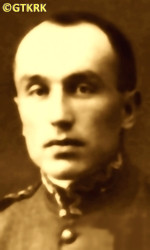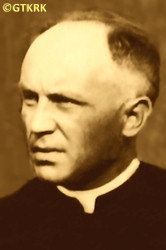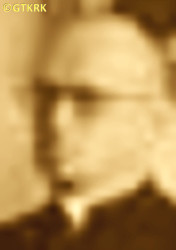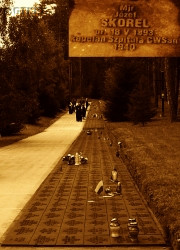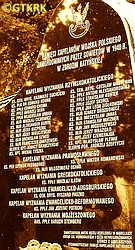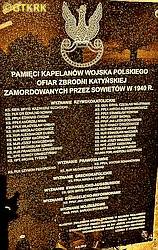Roman Catholic
St Sigismund parish
05-507 Słomczyn
85 Wiślana Str.
Konstancin deanery
Warsaw archdiocese, Poland
full list:
displayClick to display full list

searchClick to search full list by categories
wyświetlKliknij by wyświetlić pełną listę po polsku

szukajKliknij by przeszukać listę wg kategorii po polsku

Martyrology of the clergy — Poland
XX century (1914 – 1989)
personal data
surname
SKOREL
forename(s)
Joseph (pl. Józef)
function
diocesan priest
creed
Latin (Roman Catholic) Church RCmore on
en.wikipedia.org
[access: 2014.09.21]
diocese / province
Pinsk diocesemore on
en.wikipedia.org
[access: 2013.05.19]
Minsk diocesemore on
en.wikipedia.org
[access: 2013.05.19]
Mogilev archdiocesemore on
en.wikipedia.org
[access: 2013.06.23]
RC Military Ordinariate of Polandmore on
en.wikipedia.org
[access: 2014.12.20]
academic distinctions
Sacred Theology MA
honorary titles
War Order of Virtuti Militari — Silver (5th Class)more on
War Order of Virtuti Militari – Silver (5th Class)
(11.11.1976, Londontoday: London Cou., England, United Kingdom
more on
en.wikipedia.org
[access: 2024.03.19], decree of Stanislav Ostrowski, President of the Republic of Poland in exile)
September Campaign Crossmore on
September Campaign Cross
(01.01.1986, Londontoday: London Cou., England, United Kingdom
more on
en.wikipedia.org
[access: 2024.03.19], decision of George Premyslav Morawicz, Minister of Military Affairs of the Polish Government in exile)
„Cross of Independence”more on
„Cross of Independence”
(13.09.1933)
Gold „Cross of Merit”more on
Gold „Cross of Merit”
(06.10.1938)
Commemorative Medal for War of 1918–21more on
Commemorative Medal for War of 1918-21
Ten Years of Independence Medalmore on
Ten Years of Independence Medal
„For Long Service” medal — bronzemore on
„For Long Service” medal – bronze
(1938)
date and place
of death
04.1940

NKVD TverHQ at 17 4 Sovetskaya Str
today: Tver Medical Institute, Tver oblast, Russia
more on
en.wikipedia.org
[access: 2021.10.09]
alt. dates and places
of death
29.04.1940, 30.04.1940, 01.05.1940
details of death
In 05.1918 — during World War I, after the closure of the Imperial Roman Catholic Theological Academy in Sankt Petersburg, where studied, by the Bolsheviks, who in 11.1917, supported and financed by the Germans, carried out a coup d'état and took power in Russia, and after the separatist peace truce concluded by the Central Powers (Germany and Austria–Hungary) and the Bolsheviks in Brest on 03.03.1918 — sent to Babruysk. Arrived there prob. during (or just after) the disarmament by the Germans — on the basis of the Brest Agreement, the Germans took control of, among other things, over eastern Belarus — of the 1st Polish Corps stationed in Babruysk under the command of General Joseph Dowbor–Muśnicki. The Corps was formed in 1917 as a unit of the Russian Army, but after the Bolshevik putsch, due to the Bolsheviks' refusal to supply it, it took over Babruysk on 03.02.1918 and attempted to be recognized as a separate Polish army by the Germans. However, they decided to dissolve the Corps, which happened on 21.05.1918. When became the prefect of Polish school youth in Babruysk, the city was in German hands. In 11.1918, however, World War I ended with the defeat of the Central Powers and the Bolsheviks entered Babruysk. Came into contact then with activists of the clandestine Polish Military Organization POW.
His apartment became a liaison point for POW couriers. On the night of 16‐17.07.1919, after the seventh consecutive search, arrested by agents of the Russian criminal Cheka organization. „In July 1919 […] imprisoned by the Chekists for participation in the action of the Fedorowicz's, who stored weapons and ammunition received from the 1st Polish Corps and carried out a sabotage action behind the Bolshevik's lines” — was written in the application for the Cross of Independence. Interrogated by the head of the Cheka himself, the infamous Felix Dzerzhinsky. Sources state that was released after three weeks, but in the aforementioned application for the Cross of Independence it was written „happily saved”, so may have been released by the Polish Army, which entered Babruysk on 28.08.1919, during the offensive that began on 08.08.1919, which was to establish the Polish defensive lines in the Polish–Russian War of 1919‐1921 on the Berezina River.
On 29.09.1919, joined the Polish Army. Became chaplain of the 2nd Legions Infantry Regiment, which was then stationed near Barysaw, c. 140 km north of Babruysk, on the Berezina River, ministering in the „epidemic hospital”. Defending Polish positions, the Regiment took part in clashes with the Russians — i.a. became famous for his raid on 17.10.1919 on the village of Kobylshchina on the eastern bank of the Berezina River, capturing a lot of Russian weapons and equipment. On 12.01.1920 appointed chaplain of the Białystok Rifle Regiment, which was stationed in the same area. On 14‐24.01.1920, however, the Białystok Regiment was transferred to Orany in Lithuania, manning the Polish–Lithuanian demarcation line. Due to Lithuania's hostile attitude towards Poland, the Regiment served in the vicinity of Sejny, Suwałki, and later of Širvintos. On 20.04.1920 appointed chaplain of the Brest fortress on the Bug River.
On 14.08.1920 — after the capture of Brest by the Russians during the Battle of Brest of 30.07‐02.07.1920, at the very beginning of the great Battle of Warsaw (known as the „Miracle on the Vistula”), in which the Russians were defeated and which decided about the fate of the entire Polish–Russian war — became chaplain of the District Hospital in Grudziądz.
After German and Russian invasion of Poland in 09.1939 and start of the World War II participant of Warsaw defense as the chaplain of Ujazdowskie hospital.
Prob. as early as on 06.09.1939, together with the state and military authorities (including the staff of the DOK Command of the Corps District No. I Warsaw, with which was associated), left Warsaw and went east.
Reached the areas that was overtaken by the Russians and was arrested there by the Russians on 25.09.1939 in unknown circumstances.
Held in KLW Kozelsk concentration camp in Kozelsk.
On 23‐24.12.1939, in a group of 41 Polish POWs, including 9 military chaplains, moved to Butyrki prison in Moscow.
From there on 29.12.1939 transported to KLW Ostashkov concentration camp in Ostashkov.
From KLW Ostashkov — his name is on the NKVD deportation list No. 051/2 prepared on 27.04.1940, item 15 (case No. 5773), with an order to be placed at the disposal of the head of the NKVD Directorate in Tver — deported prob. in 04.1940 (the date is unknown, but judging by the date of preparation of the deportation list, deportation took place — as in other known cases — shortly thereafter) to the execution site in Tver and murdered.
By Polish Minister of Defence’s decision No. 439/MON of 05.10.2007 posthumously promoted to the rank of lieutenant colonel.
prisoner camp's numbers
5773 (KLW OstashkovClick to display the description)
cause of death
mass murder
perpetrators
Russians
sites and events
NKVD TverClick to display the description, «Katyn genocide 1940»Click to display the description, KLW OstashkovClick to display the description, Moscow (Butyrki)Click to display the description, KLW KozelskClick to display the description, Warsaw (Black Monday)Click to display the description, Ribbentrop‐MolotovClick to display the description, Pius XI's encyclicalsClick to display the description, Polish‐Russian war of 1919‐1921Click to display the description
date and place
of birth
12.06.1893

Navahrudaktoday: Navahrudak dist., Grodno reg., Belarus
more on
en.wikipedia.org
[access: 2021.07.04]
alt. dates and places
of birth
08.05.1893, 01.06.1893
parents
SKOREL Alexander
🞲 ?, ? — 🕆 ?, ?

ORLICKA Mary
🞲 ?, ? — 🕆 ?, ?
presbyter (holy orders)
ordination
15.04.1916

Sankt Petersburgtoday: Saint Petersburg city, Russia
more on
en.wikipedia.org
[access: 2020.07.31]
positions held
04.02.1934
RC senior military chaplain — Polish Armed Forces — promotion: by order of the President of the Republic of Poland of 04.02.1934, with seniority from 01.01.1934 and 7th place among the military Roman Catholic clergy, in the rank of major
1922 – 1939
RC military chaplain — Warsawtoday: Warsaw city pov., Masovia voiv., Poland
more on
en.wikipedia.org
[access: 2021.10.09] ⋄ 1st Military District Hospital (from 1927 Marshall Joseph Piłsudski's District Hospital), Corps District OK No. I Warsaw, Polish Armed Forces — also: promoter of justice in the Court of the Field Bishop of the Polish Armed Forces (1927‐1932), chaplain of the Sanitary Training Center, which included, apart from his hospital, the School of Sanitary Cadets (from 1930), alumnus of the State Teachers' Institute, chaplain and lecturer of ethics at the Higher School of Engineering (from 1936)
1922 – 1924
student — Warsawtoday: Warsaw city pov., Masovia voiv., Poland
more on
en.wikipedia.org
[access: 2021.10.09] ⋄ Department of Catholic Theology, University of Warsaw [i.e. University of Warsaw (from 1945) / clandestine University (1939‐1945) / Joseph Piłsudski University (1935‐1939) / University of Warsaw (1915‐1935) / Imperial University of Warsaw (1870‐1915)] — postgraduate specialised studies crowned on 17.02.1925 with Master of Holy Theology degree
1921 – 1922
RC military chaplain — Grudziądztoday: Grudziądz city pov., Kuyavia‐Pomerania voiv., Poland
more on
en.wikipedia.org
[access: 2021.09.02] ⋄ 8th Military District Hospital (till 1921 Garrison Hospital No. 1), Command of the Corps District DOK No. VIII Toruń, Polish Armed Forces — also: chaplain of the Camp of Non–commissioned Officer Schools (including the Central Riding School and the Military Police School)
1919 – 1921
RC military chaplain — Polish Armed Forces — during Polish–Russian War of 1919‐1921 chaplain of the 2nd Legions Infantry Regiment (from 25.09.1919), Bialystok Rifle Regiment as part of the 4th Brigade of the 1st Lithuanian–Belarusian Division (from 12.01.1920), Brest–Litovsk Fortress (from 20.04.1920), Garrison Hospital No. 1 in Grudziądz (from 14.08.1920)
from 25.09.1919
RC military chaplain — Polish Armed Forces — commissioned; on 16.12.1921 confirmed: by decree No. L. 3448 of the Commander‐in‐Chief, verified with seniority from 01.04.1920 and 51st place on the list of Roman Catholic military chaplains, in the rank of captain
1918 – 1919
prefect — Babruysktoday: Babruysk dist., Mogilev reg., Belarus
more on
en.wikipedia.org
[access: 2020.12.11] ⋄ Immaculate Conception of the Blessed Virgin Mary RC parish ⋄ Babruysktoday: Babruysk dist., Mogilev reg., Belarus
more on
en.wikipedia.org
[access: 2020.12.11] RC deanery
1916 – 1918
student — Sankt Petersburgtoday: Saint Petersburg city, Russia
more on
en.wikipedia.org
[access: 2020.07.31] ⋄ philosophy and theology, Imperial Roman Catholic Spiritual Academy (1842‐1918) — postgraduate specialised studies, interrupted after the Bolsheviks suspended the activities of the Academy
1911 – 1916
student — Sankt Petersburgtoday: Saint Petersburg city, Russia
more on
en.wikipedia.org
[access: 2020.07.31] ⋄ philosophy and theology, Metropolitan Theological Seminary
comments
During the campaign of raising funds for the renovation of Wawel castle in Kraków, „bricks” were placed in the Wawel retaining wall — stone bricks commemorating the donors. One of them, No.
3817 from 1921‐1922, reads „In honour of the heroes of Bobruysk: the late Viktor Godlewski, Sergius and Peter Fedorowicz, Vladislav Zbieranowski — Bobruysk Youth”.
others related
in death
DUBIELClick to display biography Alexander, JANASClick to display biography Mieczyslav, KACPRZAKClick to display biography Joseph, MARCOŃClick to display biography Mieczyslav, MASŁOŃClick to display biography Vladislav, MIKUCZEWSKIClick to display biography Joseph, MIODUSZEWSKIClick to display biography John, NOWAKClick to display biography Edmund, OCHABClick to display biography Vladimir, PASZKOClick to display biography Richard, ROMANOWSKIClick to display biography Victor, SZWEDClick to display biography Bronislav, WOJTYNIAKClick to display biography Ceslav, ZAKRZEWSKIClick to display biography Francis
sites and events
descriptions
NKVD Tver: On 04.04‐22.05.1940 the Russians executed in NKVD HQ building at 4 Sovetskaya Str (now Tver Medical Institute) in Tver c. 6,314 Polish prisoners of war (POW) kept in KLW Ostashkov concentration camp in Ostashkov. This genocide was the implementation of the decision of the Russian Commie‐Nazi authorities — the Politburo of the Russian Commie‐Nazi party — of 05.03.1940 to exterminate tens of thousands of Polish intelligentsia and servicemen, held in Russian camps established after the German‐Russian Ribbentrop‐Molotov Agreement and the annexation of half of Poland by the Russians in 1939, known as «Katyn genocide». After the formal „verdict”, the NKVD Special Council Moscow, i.e. the genocidal Russian kangaroo court known as the «NKVD Troika», sent successive disposition letters to the NKVD in Tver — there were c. 60 of them — containing the names of the persons to be murdered. The prisoners were brought — Tver is c. 190 km from Ostashkov — to the NKVD HQ building, identified one by one in a basement room known as the „Lenin’s room”, handcuffed, taken to another room cellar with a door covered with felt, and then murdered individually by a shot from a German Walther P38 pistol into the back of the head. The bodies where next dumped into mass graves in ditches in the Miednoje forest, in the NKVD summer resort, and covered with sand by an excavator. (more on: pl.wikipedia.orgClick to attempt to display webpage
[access: 2012.11.23], en.wikipedia.orgClick to attempt to display webpage
[access: 2014.05.09])
«Katyn genocide 1940»: 05.03.1940, the Russian Commie‐Nazi authorities — the Politburo of the Russian Commie‐Nazi party headed by Joseph Stalin — made a formal, secret decision No. P13/144 to exterminate tens of thousands of Polish intelligentsia and military personnel, „declared and hopeless enemies of the Russian government”, held in Russian camps, as a consequence of the German‐Russian Ribbentrop‐Molotov Agreement, the invasion of Poland and annexation of half of Poland in 09.1939, and the beginning of World War II. The decision was, as it were, „sanctioned” by the verdicts of the NKVD Special Council, i.e. the genocidal Russian kangaroo court known as «NKVD Troika» in Moscow. The implementation in Ukraine and Belarus was made possible by order No. 00350 of 22.03.1940 of the head of the NKVD, Lavrentiy Beria, on the „unloading of NKVD prisons”, i.e. transfer of prisoners from several prisons in Ukraine and Belarus to central prisons, e.g. in Kiev or Minsk. The genocidal «NKVD Troika», after issuing sentences, also sent to local NKVD units, NKVD disposition lists — i.e. lists of convicts — each containing on average c. 100 names. Named lists are known — may be reconstructed — for people held in the KLW Kozelsk and KLW Ostashkov camps, but not for KLW Starobilsk, known for victims from Ukrainian prisons, but not Belarusian ones. It is not even known exactly how many lists there were, mainly because the number of them sent to the NKVD in Belarus is unknown. On 03.03.1959 Alexander Shelepin, then head of the Russian KGB, in a handwritten note stated: „ Since 1940, the Committee for State Security under the Council of Ministers of Russia, has been keeping records and other materials relating to the prisoners of war and interned officers, gendarmes, policemen, etc., people from former bourgeois Poland shot that year. In total, based on the decision of the special troika of the NKVD of the USSR, 21,857 people were shot, of whom: 4,421 people in the Katyn Forest (Smolensk Oblast), 3,820 people from the Starobilsk camp near Kharkov, 6,311 people from the Ostashkov camp (Kalinin Oblast), and 7,305 people in other camps and prisons in Western Ukraine and Western Belarus. The entire operation of liquidation of the above–mentioned was carried out on the basis of the Resolution of the Central Committee of the CPSU of 05.03.1940”. The head of the NKVD recommended to the Russian leader, Nikita Khrushchev, to destroy all personal files of those shot in 1940, but to keep the minutes of the meetings of the «NKVD Troika» and confirmations of the implementation of the decisions of the «NKVD Troika». A one–sentence draft resolution was attached to the note. It is not known whether the resolution was accepted and whether the files were destroyed. The aforementioned protocols and confirmations of the «NKVD Troika» are also not known. There are indications — i.e. four so‐called „NKVD‐Gestapo Methodical Conferences” of 1939‐1940: in Brest on Bug, Przemyśl, Zakopane and Cracow — of close collaboration between Germans and Russians in realization of plans of total extermination of Polish nation, its elites in particular — decision that prob. was confirmed during meeting of socialist leaders of Germany: Mr Heinrich Himmler, and Russia: Mr Lavrentyi Beria, in another German leader, Mr Hermann Göring, hunting lodge in Rominty in Romincka Forest in East Prussia. (more on: en.wikipedia.orgClick to attempt to display webpage
[access: 2023.12.15])
KLW Ostashkov: Russian Rus. Концентрационный Лагерь для Военнопленных (Eng. POW Concentration Camp) KLW, run by genocidal Russian NKVD organization, for Poles arrested after the invasion in 1939, operating in 1939‐1940 in Ostashkov — in practice on Seliger lake Stolbnoy island and Svetlitsa peninsula, c. 11 km from Ostashkov, in a former Orthodox monastery, Niłowo‐Stołobieńska Hermitage, looted and shut down by Russian Bolsheviks in 1928. In 04.1940 6,570 were held captive there (in 11.1940 — 8397), out of which c. 6,300 were subsequently — as the fulfillment of Russian government decision to exterminate Polish intelligentsia and prisoners of war camps (Polish holocaust) — executed in Tver. Among the victims were officers of the Polish State Police, the Border Protection Corps KOP, Military Police, the Prison Service, officers and soldiers of the Polish Army, intelligence and counterintelligence officers of the Second Department of the General Staff, priests, employees of the judiciary, the fire brigade, foresters and military settlers from the eastern part of the Second Polish Republic. On another island of Lake Seliger, Gorodomla, in 1946‐1953 the Russians held a group of German specialists from Wernher von Braun's team, who, under the direction of Sergei Korolev, worked on Russian missiles. (more on: pl.wikipedia.orgClick to attempt to display webpage
[access: 2012.11.23])
Moscow (Butyrki): Harsh transit and interrogation prison in Moscow — for political prisoners — where Russians held and murdered thousands of Poles. Founded prob. in XVII century. In XIX century many Polish insurgents (Polish uprisings of 1831 and 1863) were held there. During Communist regime a place of internment for political prisoners prior to a transfer to Russian slave labour complex Gulag. During the Great Purge c. 20,000 inmates were held there at any time (c. 170 in every cell). Thousands were murdered. (more on: en.wikipedia.orgClick to attempt to display webpage
[access: 2020.05.01])
KLW Kozelsk: Russian Rus. Концентрационный Лагерь для Военнопленных (Eng. POW Concentration Camp) KLW, run by genocidal Russian NKVD organization, for Poles arrested after the invasion in 1939, operating in 1939‐1940 in Kozelsk — on the premises of the 18th century Orthodox Stauropygial Introduction of the Mother of God into the Temple Optyn Monastery, shut down and robbed by the Russian Bolsheviks in 1923. In 04‐05.1940, c. 4,594 people were detained there, who were then — as part of the implementation of the decision of the Russian authorities to exterminate dozens thousands of Polish intelligentsia and military personnel — murdered in Katyn. The prisoners included one rear admiral of the Polish Navy, four generals, c. 100 colonels and lieutenant colonels, c. 300 majors and c. 1,000 captains and captains of the Polish Army. Around half of them were reserve officers, including: 21 professors, associate professors and lecturers at universities, over 300 doctors, several hundred lawyers, several hundred engineers, several hundred teachers and many writers, journalists and publicists. There was also one woman, 2nd Leutenant pilot Janine Lewandowska. (more on: pl.wikipedia.orgClick to attempt to display webpage
[access: 2012.11.23])
Warsaw (Black Monday): German Germ. Luftwaffe (Eng. Air Force) the first air raids on Warsaw — attacking, among others, Warsaw housing estates — carried out on the first day of the war, 01.09.1939. The first major German assault on the capital on 08.09.1939 was repelled. On 17.09.1939, over 5,000 artillery shells and aircraft bombs fell on the city. On 22.09.1939, the German encirclement ring closed around Warsaw. On 25.09.1939 from 7:00 till late evening more than 400 German bombers made aerial raids on Warsaw. Almost 630 tons of explosives, both incendiary and demolishing were dropped. Caused c. 200 fires. Public building were not spared, including hospitals clearly marked with Red Cross signs (in fact they were targeted in the first place). Holy Ghost hospital was among them and c. 700 people, both patients and staff were killed (including 20 Vincentian sisters). Altogether during those saturation raids called „Black Monday” c. 10,000 people perished, 35,000 were wounded, mostly civilian. The raids were in contravention of Hague agreements and must be regarded as an act of war crime. (more on: pl.wikipedia.orgClick to attempt to display webpage
[access: 2015.04.18])
Ribbentrop‐Molotov: Genocidal Russian‐German alliance pact between Russian leader Joseph Stalin and German leader Adolf Hitler signed on 23.08.1939 in Moscow by respective foreign ministers, Mr. Vyacheslav Molotov for Russia and Joachim von Ribbentrop for Germany. The pact sanctioned and was the direct cause of joint Russian and German invasion of Poland and the outbreak of the World War II in 09.1939. In a political sense, the pact was an attempt to restore the status quo ante before 1914, with one exception, namely the „commercial” exchange of the so‐called „Kingdom of Poland”, which in 1914 was part of the Russian Empire, fore Eastern Galicia (today's western Ukraine), in 1914 belonging to the Austro‐Hungarian Empire. Galicia, including Lviv, was to be taken over by the Russians, the „Kingdom of Poland” — under the name of the General Governorate — Germany. The resultant „war was one of the greatest calamities and dramas of humanity in history, for two atheistic and anti‐Christian ideologies — national and international socialism — rejected God and His fifth Decalogue commandment: Thou shall not kill!” (Abp Stanislav Gądecki, 01.09.2019). The decisions taken — backed up by the betrayal of the formal allies of Poland, France and Germany, which on 12.09.1939, at a joint conference in Abbeville, decided not to provide aid to attacked Poland and not to take military action against Germany (a clear breach of treaty obligations with Poland) — were on 28.09.1939 slightly altered and made more precise when a treaty on „German‐Russian boundaries and friendship” was agreed by the same murderous signatories. One of its findings was establishment of spheres of influence in Central and Eastern Europe and in consequence IV partition of Poland. In one of its secret annexes agreed, that: „the Signatories will not tolerate on its respective territories any Polish propaganda that affects the territory of the other Side. On their respective territories they will suppress all such propaganda and inform each other of the measures taken to accomplish it”. The agreements resulted in a series of meeting between two genocidal organization representing both sides — German Gestapo and Russian NKVD when coordination of efforts to exterminate Polish intelligentsia and Polish leading classes (in Germany called «Intelligenzaktion», in Russia took the form of Katyń massacres) where discussed. Resulted in deaths of hundreds of thousands of Polish intelligentsia, including thousands of priests presented here, and tens of millions of ordinary people,. The results of this Russian‐German pact lasted till 1989 and are still in evidence even today. (more on: en.wikipedia.orgClick to attempt to display webpage
[access: 2015.09.30])
Pius XI's encyclicals: Facing the creation of two totalitarian systems in Europe, which seemed to compete with each other, though there were more similarities than contradictions between them, Pope Pius XI issued in 03.1937 (within 5 days) two encyclicals. In the „Mit brennender Sorge” (Eng. „With Burning Concern”) published on 14.03.1938, condemned the national socialism prevailing in Germany. The Pope wrote: „Whoever, following the old Germanic‐pre‐Christian beliefs, puts various impersonal fate in the place of a personal God, denies the wisdom of God and Providence […], whoever exalts earthly values: race or nation, or state, or state system, representatives of state power or other fundamental values of human society, […] and makes them the highest standard of all values, including religious ones, and idolizes them, this one […] is far from true faith in God and from a worldview corresponding to such faith”. On 19.03.1937, published „Divini Redemptoris” (Eng. „Divine Redeemer”), in which criticized Russian communism, dialectical materialism and the class struggle theory. The Pope wrote: „Communism deprives man of freedom, and therefore the spiritual basis of all life norms. It deprives the human person of all his dignity and any moral support with which he could resist the onslaught of blind passions […] This is the new gospel that Bolshevik and godless communism preaches as a message of salvation and redemption of humanity”… Pius XI demanded that the established human law be subjected to the natural law of God , recommended the implementation of the ideal of a Christian state and society, and called on Catholics to resist. Two years later, National Socialist Germany and Communist Russia came together and started World War II. (more on: www.vatican.vaClick to attempt to display webpage
[access: 2023.05.28], www.vatican.vaClick to attempt to display webpage
[access: 2023.05.28])
Polish‐Russian war of 1919‐1921: War for independence of Poland and its borders. Poland regained independence in 1918 but had to fight for its borders with former imperial powers, in particular Russia. Russia planned to incite Bolshevik‐like revolutions in the Western Europe and thus invaded Poland. Russian invaders were defeated in 08.1920 in a battle called Warsaw battle („Vistula river miracle”, one of the 10 most important battles in history, according to some historians). Thanks to this victory Poland recaptured part of the lands lost during partitions of Poland in XVIII century, and Europe was saved from the genocidal Communism. (more on: en.wikipedia.orgClick to attempt to display webpage
[access: 2014.12.20])
sources
personal:
www.bochenia.plClick to attempt to display webpage
[access: 2017.01.21], www.katedrapolowa.plClick to attempt to display webpage
[access: 2014.05.09], kapelanikatynscy.plClick to attempt to display webpage
[access: 2023.01.13], episkopat.plClick to attempt to display webpage
[access: 2019.10.13]
bibliographical:
„Lexicon of Polish clergy repressed in USSR in 1939‐1988”, Roman Dzwonkowski, SAC, ed. Science Society KUL, 2003, Lublin
original images:
episkopat.plClick to attempt to display webpage
[access: 2019.10.13], kapelanikatynscy.plClick to attempt to display webpage
[access: 2023.01.13], polesie.orgClick to attempt to display webpage
[access: 2020.07.31], www.moremaiorum.plClick to attempt to display webpage
[access: 2018.09.02], katedrapolowa.plClick to attempt to display webpage
[access: 2017.01.21], radio.lublin.plClick to attempt to display webpage
[access: 2022.05.23], ofm.krakow.plClick to attempt to display webpage
[access: 2022.05.23], www.katedrapolowa.plClick to attempt to display webpage
[access: 2014.01.16], ipn.gov.plClick to attempt to display webpage
[access: 2019.02.02]
LETTER to CUSTODIAN/ADMINISTRATOR
If you have an Email client on your communicator/computer — such as Mozilla Thunderbird, Windows Mail or Microsoft Outlook, described at WikipediaPatrz:
en.wikipedia.org, among others — try the link below, please:
LETTER to CUSTODIAN/ADMINISTRATORClick and try to call your own Email client
If however you do not run such a client or the above link is not active please send an email to the Custodian/Administrator using your account — in your customary email/correspondence engine — at the following address:

giving the following as the subject:
MARTYROLOGY: SKOREL Joseph
To return to the biography press below:
 Click to return to biography
Click to return to biography








